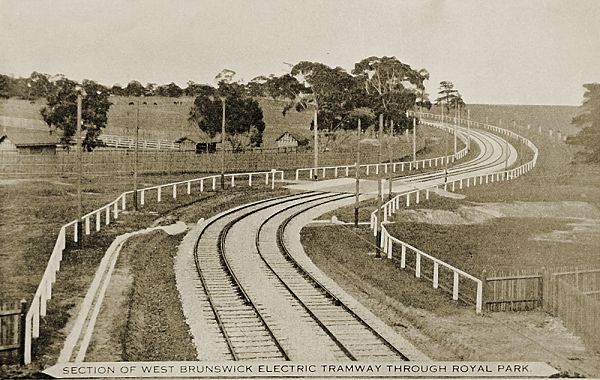Melbourn Tram Museum home
Melbourne Tram Museum
- Follow Melbourne Tram Museum on Twitter
- Follow Melbourne Tram Museum on Facebook
- Follow Melbourne Tram Museum on Instagram
- Follow Melbourne Tram Museum on Pinterest
- Follow Melbourne Tram Museum on Tumblr
- Subscribe to Melbourne Tram Museum's RSS feed
- Email Melbourne Tram Museum
A winding road
A defining characteristic of the West Coburg electric tramway is its meandering route through Royal Park and the suburbs to its north. It was the first “greenfields” tramline to be constructed by the M&MTB, and its route required considerable negotiation with landowners.
Each curve and deviation has a story to tell.
- The route through Royal Park is described in precise surveyor’s detail in the Melbourne to West Brunswick Tramways Construction Act (1922). The curves south of Elliott Avenue were likely the negotiated path around some of the sporting facilities of the 1920s that no longer exist. The curves between the railway underpass and Brunswick Road were to avoid a railway level crossing while still serving the station, and then to connect with the existing Grantham Street through a golf course and a market garden.
- Where Melville Road begins at Dawson Street, a long radius curve through private land was chosen instead of a right angle turn and ascent along Daly Street. The chosen route provided better gradient and visibility for both trams and motor vehicles. It also provided the location for the tramway’s electrical substation.
- The curve at Melville Road and Hunter Street is where the new extension from the south joined the existing Melville Street. At this time Melville Street extended from Hunter Street to Albion Street. For the first two years, the permanent way from Hunter Street to Albion Street was only a single track.
- From Albion Street, Melville Road was built through open land, over a watercourse and into Howie Street to reach Moreland Road. The curves at Moreland Road were required because Howie Street did not align with the vacant land available to extend Melville Road north of Moreland Road.
- Between Lever Street and Reynard Street, the northwest deviation of Melville Road was built through open land to line up with a suitable street in a new subdivision north of Reynard Street. The options were Victoria Parade (now Springhall Parade) or Imperial Avenue (now Melville Road). Both could be extended northward into Derby Street and both could be widened to make a tramway avenue, which was the initial M&MTB proposal. While depicted as narrow residential streets on maps of the day, most of the area was still undeveloped open land that allowed for these changes. For the first 19 years, the permanent way from Reynard Street to Bell Street was only a single track.
- North of Bell Street, it appears that Turner Street was only developed after tramway construction ceased in 1927. According to a long time resident, a reserved strip of land remained along the centre of Turner Street until the late 1950s/early 1960s – perhaps in the hope of a future tramway extension.
- The southwest corner of Bell Street and Melville Road was a vacant block of land with a standard T intersection until the late 1950s. Children played on this grassed block while parents shopped. In the late 1950s, the land was developed with the curved roadway and shops as they are today.

The newly constructed permanent way viewed from just south of the Melbourne to Fawkner railway embankment (c1925). Note the clean ballast under the track, the new platform stop and the timber picket fence around the Zoo.- Photograph from the Ron Scholten collection.